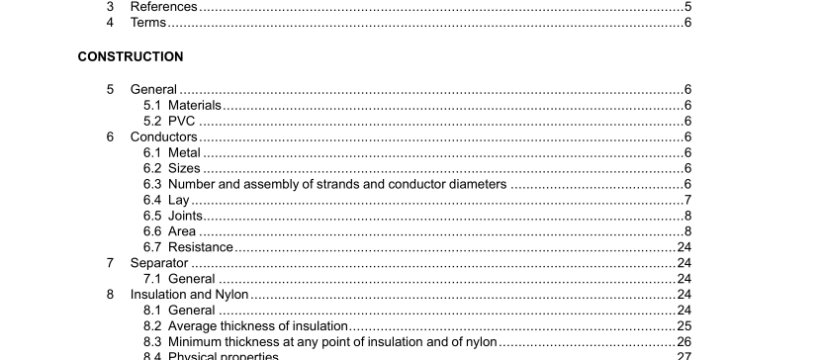UL 1063-2020 pdf download.Machine-Tool Wires and Cables.
4 Terms 4.1 Wherever the designation “UL 1581” is used in this wire standard, reference is to be made to the designated part(s) of the Reference Standard for Electrical Wires, Cables, and Flexible Cords (UL 1581). CONSTRUCTION 5 General 5.1 Materials 5.1.1 Each material used in a machine-tool wire or cable shall be compatible with all of the other materials used in the wire or cable. 5.2 PVC 5.2.1 Wherever “PVC” appears in these requirements the intention is to designate a synthesized compound whose characteristic constituent is polyvinyl chloride or a copolymer of vinyl chloride and vinyl acetate. 6 Conductors 6.1 Metal 6.1.1 Each conductor shall be only of stranded soft-annealed copper with or without continuous coating of tin or a tin/lead alloy applied before the conductor is stranded or insulated. 6.2 Sizes 6.2.1 Conductors shall not be smaller than 22 AWG and shall not be larger than 1000 kcmil. 6.2.2 The size of each conductor shall be verified either by determination of the d-c resistance or by determination of the cross-sectional area as described in 6.6.1. Determination of the conductor size by measurement of the direct-current resistance as described in 6.7.1 is the referee method in all cases.
6.3 Number and assembly of strands and conductor diameters 6.3.1 Conductors shall be stranded with at least the number of strands indicated in the applicable Table 6.5, Table 6.6, or Table 6.7. A 19-wire combination round-wire unilay-stranded soft-annealed copper conductor shall be round and shall consist of a straight central wire, an inner layer of six wires of the same diameter as the central wire with the six wires having identical lengths of lay, and an outer layer consisting of six wires of the same diameter as the central wire alternated with six smaller wires having a diameter of 0.732 times the diameter of the central wire and with all twelve wires of the outer layer having the same length of lay and direction of lay as the six wires of the inner layer. Otherwise, no particular assembly of the individual strands is required; however, untwisted strands shall not be used for the entire conductor or any part thereof. Class B or C 16 AWG – 1000 kcmil conductors shall be with or without compressed strands. Compressed stranding shall not be used in the Size 22-7 or in the Class K and M constructions. Otherwise, any stranding other than single-bunch, bunch stranding and the concentric, rope-lay, and 19- wire combination unilay assemblies indicated in Table 6.5, Table 6.6, and Table 6.7 shall not be used unless the results of an evaluation demonstrate that the stranding is appropriate for the application. Compact stranding shall not be used.
6.3.2 A compressed round concentric-lay-stranded conductor shall be a round conductor consisting of a central core wire surrounded by one or more layers of helically laid wires with, for the 6 AWG – 1000 kcmil sizes, the direction of lay reversed in successive layers or unilay or unidirectional lay. The direction of lay of the outer layer shall be left-hand in all cases. The strands of one or more layers shall be slightly compressed by rolling, drawing, or other means to slightly change the originally round strands to various shapes that fill some of the spaces originally present between the strands. 6.3.3 A finished compressed-stranded Class B or C conductor shall not be larger in average diameter than the maximum diameter indicated for the size under Y in Table 6.5 and shall not be smaller in average diameter than the minimum diameter indicated for the size under Z in Table 6.5 Class B or C 16 AWG – 1000 kcmil conductors with uncompressed strands shall not be larger or smaller in average diameter than the maximum and minimum diameters indicated for the size in Tables 20.4 (Class B) and 20.4.1 (Class C) of UL 1581. The average diameter of the conductor is to be determined and compared with the table in the manner described in 6.3.4 and 6.3.5. Class B 1 AWG – 1000 kcmil conductors with round unilay or unidirectional lay compressed strands shall not be larger or smaller in average diameter than the maximum and minimum diameters indicated for the size in Table 20.3.1 of UL 1581. A finished 19-wire combination unilay conductor shall not be larger in average diameter than the maximum diameter indicated for the size in Table 20.6 of UL 1581. The average diameter of a conductor is to be determined and compared with the tables in the manner described in 6.3.4 and 6.3.5.UL 1063-2020 pdf download.
UL 1063-2020 pdf download
